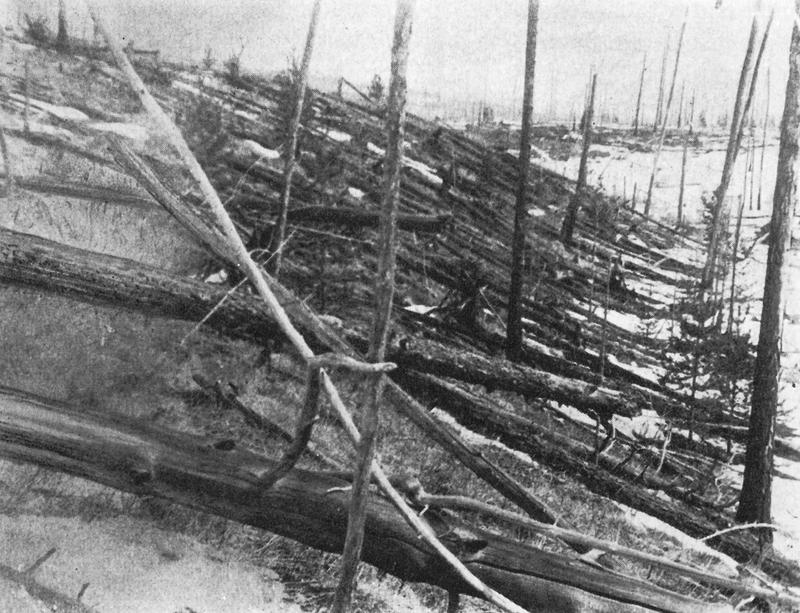Tunguska Event: The Truth is Out There

At approximately 7 AM on the morning of June 30th, 1908, a bright falling star—described as "splitting the sky in two"1—was observed by thousands of people living in the Krasnoyarsk Territory in Siberia. Witnesses reported seeing a flash as bright as a second sun. The ground shook, trees caught on fire and some were flung through the air. Some only heard the thunderous shock, which registered as a magnitude 5 earthquake on the Richter scale by seismographs near the site. According to this 1960s report from Radio Moscow:
It was heard 700 miles away. Instruments registered it in Saint Petersburg, Berlin, London and even Washington. The explosion produced strange disturbances in the atmosphere. The first two nights after the blast were so light that people in Paris could read newspapers and Londoners could even take pictures [without a flash bulb].
Because the event occurred in a remote, swampy area of the Tunguska region, there were no published investigations of the crash site for almost 20 years; Leonid Kulik, a Russian mineralogist led the first expedition in 1927. A 1929 article in the New York Times describes the scene, based on his observations:
In the centre there is an area several miles in diameter, where the earth is torn and furrowed as though by a gigantic harrow, and also pitted, in places, with numerous large circular excavations resembling lunar craters. Around this centre is a broad zone in which lie millions of trees, stripped of bark and branches, and all with their tops pointing outward. They bear marks of a uniform scorch, quite different from the effects of an ordinary forest fire. These trees, some of which are of great size, were evidently blown down by the blast of air produced by the fall of the meteoric mass. The same blast knocked down human beings and damaged houses fifty miles away.
A Tungus [indigenous person of this region] told Kulik that one of his relatives had stores and a herd of 1,500 domestic reindeer in the forest when the meteorite fell. These were all destroyed. Only a few scorched carcasses of the animals could be found; the storehouse was burned down; tools were completely melted.
Contrary to expectation, Kulik did not find an impact crater or debris from the foreign object. He reported an epicenter of trees still standing, but scorched and stripped of their branches like a group of telephone poles.
If this sounds like a good cold open for an episode of the X-Files, the Tunguska event did make a cameo appearance on that TV series, which insinuated the object carried a parasitic alien organism! Indeed, theories persist that this was the crash site for an alien space craft, a miniature black hole, an antimatter collision or punishment from a higher power.
However, the event was most likely caused by an asteroid or comet, which came in contact with the earth's atmosphere and exploded shortly before hitting the surface, leveling nearly 800 square miles of trees. This mid-air explosion, known as a superbolide, is believed to have been 1,000 times greater than the atomic bomb that destroyed Hiroshima.
One can imagine how brilliant and terrifying the Tunguska object must have been to those that witnessed its descent towards earth. A similar event happened in 2013 in which a much smaller meteor exploded in the earth’s atmosphere near Chelyabinsk Oblast in the Ural Mountains. Compared to Tunguska, this event was only 29 times greater than the Hiroshima bomb.
Meteor over Chelyabinsk, footage taken by Aleksandr Ivanov.
(Wikimedia Commons)
Audio courtesy of the NYC Municipal Archives WNYC Collection.
WNYC archives id: 150282
Municipal archives id: T4052
[1] Rincon, Paul. "Fire in the sky: Tunguska at 100." BBC News.
Hogenboom, Melissa. "In Sibera in 1908, a huge explosion came out of nowhere." BBC Earth.
Science@NASA, "The Tunguska Impact--100 Years Later"
Perkins, Sid. "A Century Later, Scientists Still Study Tunguska: Asteroid or Comet Blamed for Siberian Blast of 1908." Science News 173.19 (2008): 5-6.

